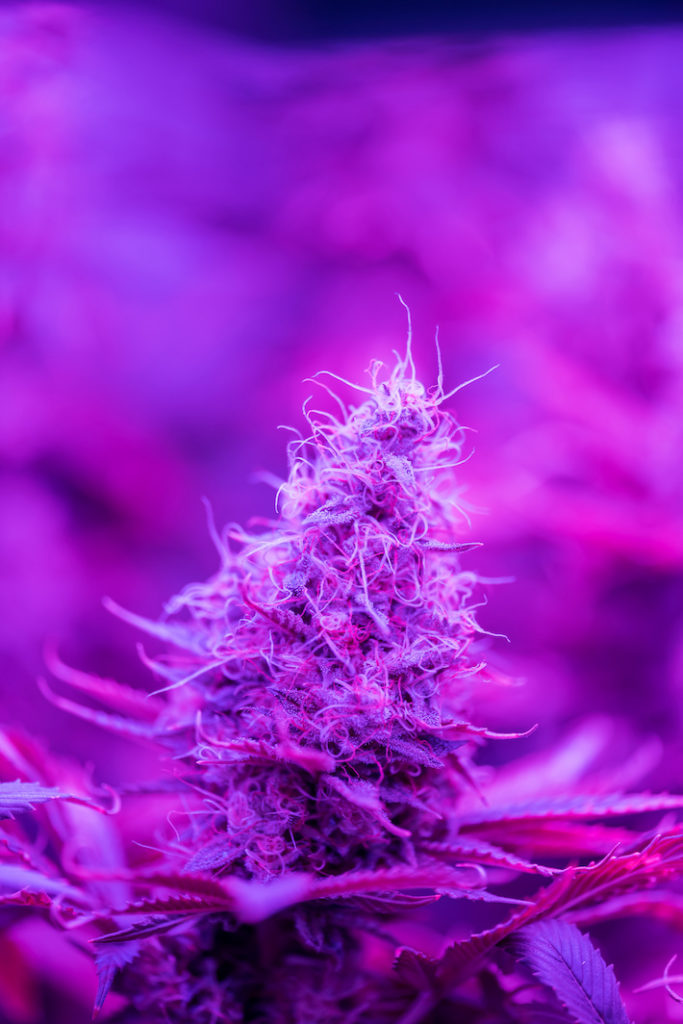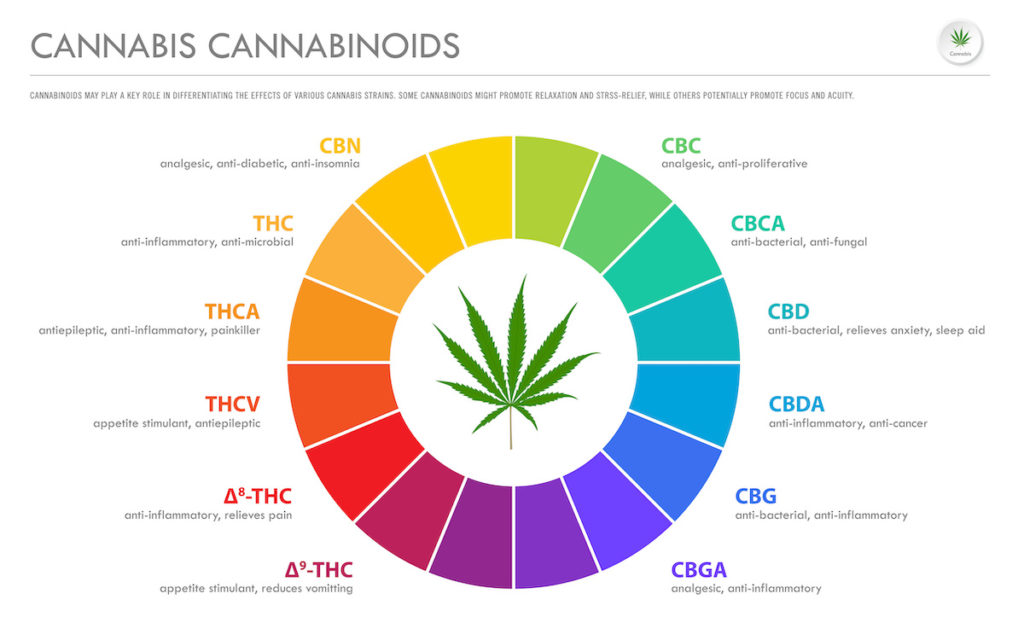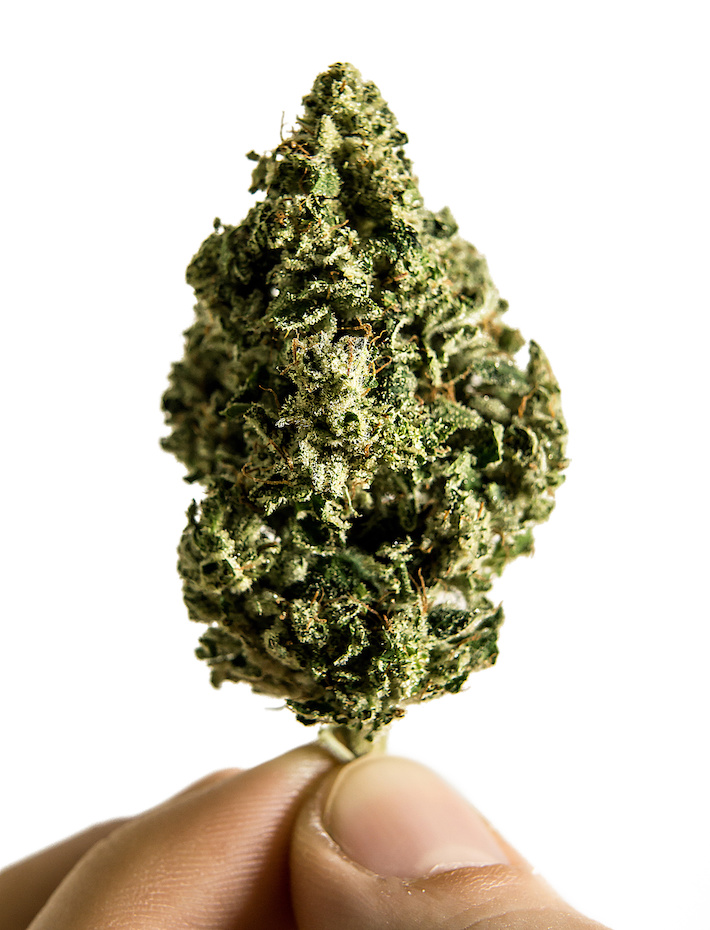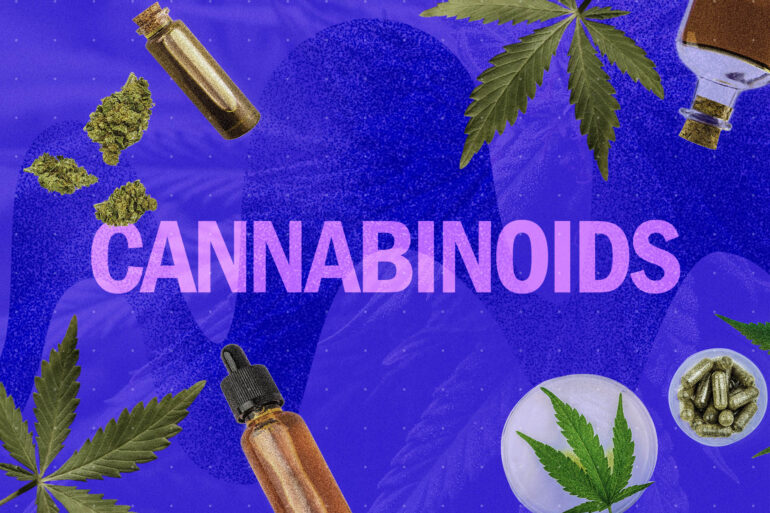Everyone talks about the effects and benefits of CBD and THC, but what about the other cannabinoids found in varieties of cannabis?
We’re sure you’ve seen confusing abbreviations such as THCA, CBV, and CBC, and thought to yourself, “what the hell are these?”
Our quick guide to every cannabinoid in cannabis will get you on your way to being an expert in no time.
What are cannabinoids and how do they work?

There are four different terms for us to dive into first:
- Phytocannabinoids
- Endocannabinoids
- The endocannabinoid system (ECS)
- Cannabinoid receptors
Phytocannabinoids are naturally-occurring chemical compounds in varieties of cannabis — “phyto” meaning they belong to the plant.
There are 113 different phytocannabinoids present in cannabis. Some are produced in abundance, whilst others are only found in smaller or trace amounts. CBD, for example, is an abundant phytocannabinoid, while a minor phytocannabinoid such as THCV isn’t.
When you consume varieties of cannabis, these phytocannabinoids enter into your body and interact with your endocannabinoids system — or ECS for short.
Your ECS is made up of clever receptors found all over the body (nervous, limbic, and immune systems) that produce endocannabinoids all on their own. These endocannabinoids help regulate a large number of functions such as mood, sleep, relaxation, appetite, memory, and body temperature.
All mammals walking this great green earth have an endocannabinoid system. Your mom does, your dad does, and your dog does — even you have one!
Sometimes, though, your body needs a cannabinoid top-up — and that’s where phytocannabinoids come in. Phytocannabinoids will interact with your ECS receptors to keep your body in the aforementioned state of homeostasis — think of it as a sort of maintenance.
Now, let’s dig into each phytocannabinoid in cannabis.
Types of Cannabinoids

| Cannabinoid | Compound |
|---|---|
| CBG | Cannabigerol |
| CBDA | Cannabidiolic acid |
| CBD | Cannabidiol |
| THCA | Tetrahydrocannabinolic acid |
| THC | Tetrahydrocannabinol |
| Delta-8 THC | Δ8-Tetrahydrocannabinol |
| THCP | Δ9-Tetrahydrocannabiphorol |
| CBN | Cannabinol |
| CBC | Cannabichromene |
| CBDV | Cannabichromevarin |
| CBGV | Cannabigerovarin |
| THCV | Tetrahydrocannabivarin |
| CBL | Cannabicyclol |
| CBV | Cannabivarin |
| CBT | Cannabicitran |
| CBGM | Cannabigerol monomethyl ether |
| CBE | Cannabielsoin |
| CBCV | Cannabichromevarin |
| THCH | Δ9-Tetrahydrocannabihexol |
CBG: the mother of all cannabinoids
I bet you’re thinking, “Why are you starting with CBG? Surely we should start with CBD?” Many guides start with CBD. It’s one of the most popular and well-known phytocannabinoids. However, popularity is quite irrelevant here. You see, CBG (cannabigerol) is known as the ”mother” of all phytocannabinoids.
In fact, cannabigerolic acid (CBGA), which is CBG’s precursor acid, is the first phytocannabinoid to be produced in varieties of cannabis. During a plant’s growth period, CBG actually turns into other phytocannabinoids including:
- THCA (Tetrahydrocannabolic acid)
- CBDA (Cannabidiolic acid)
- CBCA (Cannabichromenic acid)
When these precursor acids go through a process of decarboxylation, they’ll eventually turn into THC, CBD, and CBC, respectively.
CBG is particularly useful as a treatment for pain, inflammation, and nausea (similar to CBD), and is effective at counteracting the intoxicating feeling associated with THC.
You have the option to purchase specifically-made oils with high CBG content or CBD oils with a large percentage of CBG. If you choose the latter, always check the COA to determine how much CBG is in the formula/extract.
CBG potential health benefits:
CBG side effects:
To the best of our knowledge, neither CBG or CBGA are known to cause any side-effects.
CBDA: the precursor acid to CBD
Next up is CBDA (cannabidiolic acid). This phytocannabinoid was first isolated as recently as 1996 and is the precursor acid of the goliath known as CBD.
In fact, CBDA is incredibly abundant in raw cannabis — much like THCA. Once cannabis goes through the decarboxylation process (exposed to heat or air/light), CBDA will turn into CBD. When exposed to light and air, this process happens gradually. When exposed to heat, this process happens almost immediately. You can find high levels of CBDA in hemp seed oil, specifically, due to different extractions processes.
CBDA’s advantage is it inhibits the cyclooxygenase-2 (COX-2) enzyme. This enzyme causes inflammation and pain, particularly after an injury or infection. This anti-inflammatory quality associated with CBDA consumption is perfect for athletes and workers with labor-intensive jobs.
CBDA potential health benefits:
- Combats inflammation
- Boosts serotonin levels
- Aids depression
- Promising results for treating epilepsy & seizures
CBDA side-effects:
To the best of our knowledge, CBDA has no proven side-effects.
CBD: arguably the most well-known cannabinoid (behind THC)
CBD, otherwise known as cannabidiol, is the second-most abundant phytocannabinoid found in varieties of cannabis (behind THC). It’s the “activated” form of CBDA during and after decarboxylation.
CBD is non-intoxicating but highly beneficial for the mind and body, which is why it’s so popular amongst users. You can find a huge amount of CBD-based products all over the world, ranging from oils and vape liquids to topicals and transdermal patches.
CBD is best known for its anti-anxiety, anti-inflammatory, anti-seizure, and neuroprotective qualities. However, scientific research suggests it can also help treat pain, acne, and cancer-related symptoms with it too. This makes CBD an almighty all-rounder for you to indulge in.
Acne and other skin-related problems are best treated using a high-CBD topical balm or salve. Localized muscle pain and joint inflammation should also be treated using a high-CBD topical as well — always look for a specialized muscle rub or joint pain cream for maximum relief.
Anxiety, depression, or other psychological ailments are better treated with a full-spectrum CBD oil — preferably a 1000mg strength option. You can also use capsules or pills too. They’re better if you’re looking for a pre-measured dose of CBD. A 40-50mg capsule should do the trick.
CBD potential health benefits:
CBD side-effects:
- Loss of appetite
- Drowsiness
- Fatigue
- Diarrhea
THCA: THC’s precursor acid
THCA (tetrahydrocannabinolic acid) is THC’s precursor acid — it’s also the most abundant phytocannabinoid in fresh, growing, and undried varieties of cannabis. Once THCA is exposed to light or heat, it begins to form into THC.
However, just because THCA is the acid that turns into THC doesn’t instantly mean it’s psychotropic or intoxicating. In fact, it’s quite the opposite. That’s why “juicing” or blending raw, undried cannabis into drinks has become so popular. You can also purchase THCA in raw powder form and in drinks and tinctures as well).
Preliminary studies, as well as user stories around the world, also claim that THCA may have some of the same health benefits of THC.
THCA is a fantastic anti-inflammatory and ideal for pain relief — much like THC. It’s also known as an effective neuroprotectant and has been shown to potentially treat neurological conditions such as Alzheimer’s disease and multiple sclerosis.
If you’re in the market for a THCA product, I personally recommend a tincture with medium-chain triglyceride (MCT) carrier oil for increased absorption and bioavailability.
THCA potential health benefits:
THCA side-effects:
- Sedative-like effects (anecdotal)
- Energizing (anecdotal)
THC: arguably the most well-known cannabinoid (behind CBD)
Firstly, let’s get the confusion out of the way. There are four different types of THC (tetrahydrocannabinol) in varieties of cannabis:
- THCA (which we just discovered earlier)
- THCV (Tetra
- Delta-8-tetrahydrocannabinol (otherwise known as Δ-8-tetrahydrocannabinol or Δ-8-THC)
- Delta-9-tetrahydrocannabinol (otherwise known as Δ-9-tetrahydrocannabinol, Δ-9-THC, or simply THC)
We’ve covered all of these in our Beginner’s Guide to THC. However, I’m here to talk to you about the last one on that list — delta-9-tetrahydrocannabinol, which is commonly referred to as just THC.
THC is known as the most abundant intoxicating and psychotropic phytocannabinoid in varieties of cannabis when exposed to light or heat. In certain quantities (depending on how tolerant and/or sensitive you are), THC will get you “high” or feeling otherworldly.
Aside from CBD, THC is the granddaddy when it comes to how it can benefit you. It’s a very effective anti-inflammatory, anti-convulsant, and pain reliever. It’s also known to help with insomnia, as well as other sleep-related disorders. Be careful with THC, however. If you’re a beginner, you’re best off sticking to a high-CBD, low-THC cannabis strain or cannabis oil. Perhaps look for a CBD:THC ratio of 18:1 or 8:1.
THC potential health benefits:
- ADHD
- Depression, stress, and anxiety
- Insomnia & sleep-related issues
- Seizures
- Low libido/sex drive
- Pain relief
THC side-effects:
- Lethargy
- Drowsiness
- Nausea & vomiting (if you take too much)
- Increased heart rate
- Red eyes
- Memory loss
- Visual impairment
- Mental impairment
Delta-8 THC: the less potent cousin of delta-9-THC
Delta-8 THC is an abbreviation of delta-8-tetrahydrocannabinol. Also known as Δ8-THC. It’s closely-related to delta-9 THC. Molecularly similar but with one difference between them. Delta-8 THC has a “double bond” on the 8th carbon chain. Delta-9 THC has a double bond on the 9th. The difference is small but significant.
Delta-8 is less potent than delta-9. It doesn’t bind quite as strongly to your CB1 receptors. Causes some intoxication in mild-to-moderate doses but not enough to give you a whopping high. Delta-8 is typically useful for users looking for a mild-to-moderate high experience without overwhelming anxiety, paranoia, or other negative side-effects commonly associated with delta-9.
Similar to other THC variants, varieties of cannabis don’t carry high percentages of delta-8. Usually no more than 1%. Cannabis brands and companies have managed to isolate and produce it in higher quantities. Useful for symptoms of pain, inflammation, anxiety (in mild doses), and appetite stimulation.
Delta-8 potential health benefits:
Delta-8 side-effects:
- Drowsiness
- Fatigue
- Anxiety (in high doses)
- Paranoia (in high doses)
- Nausea (in high doses)
- Vomiting (in high doses)
THCP: potentially the most potent THC variant
THCP is short for Δ9-tetrahydrocannabiphorol. It was discovered in 2019 by a group of Italian researchers using advanced mass-spectrolomy and liquid chromatography technology on a naturally-sourced cannabis sample named FM2. The sample was provided by the Military Chemical Institute in Florence.
What’s interesting about THCP is its molecular structure. Regular THC has five alkyl side chains (carbon atoms), which indicates a high binding affinity with CB1 receptors and produces a significant “high”.
THCP has seven alkyl side chains, two more than regular THC. This indicates a very high binding affinity with CB1 receptors and could potentially produce a stronger “high” experience. In fact, researchers believe THCP is thirty times more effective than regular THC at binding with CB1 receptors.
Currently, there are one or two THCP-centered products on the market, though we’re unsure of their quality, effectiveness, and legitimacy.
THCP potential health benefits:
The Italian researchers tested THCP on rodent test subjects, which resulted in:
- Increased hypomobility
- Pain-relief
- Decreased temperature in the rectum
THCP side-effects:
It’s unknown if THCP produces any side-effects. Clinical testing isn’t underway. There’s very little (if any) anecdotal evidence. We can only presume side-effects are similar to THC, which include:
- Anxiety
- Paranoia
- Self-consciousness
- Fatigue
- Sleepiness
- Drowsiness
- Red eyes
- Memory loss
- Nausea
- Vomiting
CBN: was once totally misunderstood
CBN (cannabinol) was actually the first phytocannabinoid to be isolated from cannabis back in 1896.
In fact, many believed CBN was the primary intoxicating compound in cannabis until THC showed up. Cool, huh?
With further research, we know that over time (as cannabis “buds” start to age) THC actually turns into CBN — this process is called oxidation. However, despite this process, CBN isn’t intoxicating like THC is.
CBN is good for sleep and results in greater sedation when paired with THC. Studies show it has powerful anticonvulsant and anti-seizure properties.
One key difference between much of the hemp on sale vs higher quality CBD is the amount of CBN within it. It’s worth purchasing CBD with notable lab-studied evidence of CBN content if you’re in the market for this area.
CBN potential health benefits:
CBN side-effects:
- Appetite loss
- Drowsiness
- Dizziness
CBC: abundant in younger varieties of cannabis
CBC (cannabichromene) is a non-intoxicating phytocannabinoid first discovered in 1964. Despite being one of the major phytocannabinoids found in varieties of cannabis, it’s still relatively understudied in comparison to its THC and CBD brothers.
CBC comes from its precursor acid CBDA after decarboxylation and is typically abundant in younger, more juvenile varieties of cannabis. Over time, as the plant begins to mature, you’ll find less CBCA (and, by extension, CBC).
CBC is known mainly for its pain-relieving properties. It attaches itself to what’s known as your vanilloid receptor 1 (TRPV1), which produces analgesic and anti-inflammatory effects, thus managing pain perception. You can’t get high-CBC products but you can purchase broad or full-spectrum CBD oils (as well as other products) with a CBC in it, albeit in smaller amounts.
CBC potential health benefits:
- Combats pain and inflammation (in conjunction with THC)
- Soothes acne
- Alleviates depression (in conjunction with both CBD and THC)
CBC side-effects:
To the best of our knowledge, there are no proven side-effects.
CBDV: commonly found in “wild” cannabis
CBDV (cannabichromevarin) is very similar to CBD in terms of molecular structure — they both aren’t intoxicating and certainly won’t get you high. You commonly find high-concentrations of CBDV in “landrace” strains that haven’t been manipulated or influenced by human experimentation — in other words, it’s from varieties of cannabis left to grow free in the wild.
Research suggests CBDV (alongside anti-epileptic drugs) showed promise as an anti-seizure treatment in rat and mice test subjects — though, of course, more needs to be looked at here. Human trials need to be conducted before anything can be claimed with 100% certainty.
However, we do know CBDV is an effective analgesic and mood-enhancer, which is useful if you’re suffering from pain-related symptoms or psychological ailments, respectively. If you’re looking to get your hands on CBDV, you’re going to want to focus your attention on landrace indica strains or a CBD oil with a high percentage of CBDV.
CBDV potential health benefits:
CBDV side-effects:
No reported side-effects.
CBGV: helps your cell receptors “accept” THC
As the abbreviation suggests, CBGV (cannabigerovarin) is an analog of CBG — or, rather, it has a very similar molecular structure where the only difference is their carbon rings.
Though little is known about CBGV compared to the other major phytocannabinoids under the spotlight, there’s a suggestion that it may “help the body’s cell receptors more readily accept and utilize THC when ingested”. It’s also totally non-intoxicating.
CBGV is very similar to CBG insofar as health benefits. It’s a solid antibacterial and analgesic, and has been proven to combat signs of dry skin, as well as inflammatory bowel disease (IBS) and bladder dysfunction.
Because CBGV is a reasonably rare cannabinoid to find in cannabis-derived products, make sure to check each product’s COA.
CBGV potential health benefits:
CBGV side effects:
No reported side-effects.
THCV: helps with stimulation and energization
There’s a huge amount of interest in THCV (tetrahydrocannabivarin). Its molecular structure is very similar to THC’s and acts as an “antagonist” to THC’s effects — in other words, counteracting THC’s psychological effects.
However, THCV is psychoactive all on its own, but not in the same way as THC. Users report a more energizing and stimulating high, as opposed to the mental cloud often attributed to THC use. THCV is also very prominent in African and Asian strains, but only in trace amounts.
Akin to CBGV, THCV is a pretty rare cannabinoid, which sucks because it’s an effective anti-inflammatory, antipsychotic, and appetite-suppressant. Fortunately, there are a few companies out there producing high-THCV products.
THCV potential health benefits:
- Antipsychotic (schizophrenia)
- Anti-inflammatory
- Combats obesity & diabetes
THCV side-effects:
- Appetite loss
The lesser-known and under-studied phytocannabinoids

CBL: quite an unknown minor phytocannabinoid
Out of every phytocannabinoid found in varieties of cannabis, CBL (cannabicyclol) is quite possibly the one with the least amount of spotlight shining on it. This, unfortunately, leaves it very much unknown and overshadowed by its THC and CBD brothers.
CBV: non-psychotropic (and very much unknown)
Much like CBL, CBV (cannabivarin) isn’t heavily researched — in fact, there aren’t any studies at all (from what I understand, at least). What I do know, however, is it’s not particularly abundant in varieties of cannabis. It’s also similar to CBD insofar as it isn’t intoxicating or psychotropic.
CBT: found in “Type III” cannabis strains
CBT (cannabicitran) is another phytocannabinoid that’s practically a mystery to scientists and researchers — though there is more interest now than ever before, which is awesome. I think this could be quite a promising phytocannabinoid. From what I know, this CBT is more prevalent in distillates from Type III cannabis flower — Type III refers to high-CBD, low-THC strains.
As of September of last year, research is underway to see what this phytocannabinoid can actually do. Let’s keep our fingers crossed for some awesome and mind-blowing results!
CBGM: one of two “ether” cannabinoids
As the name suggests, CBGM (cannabigerol monomethyl ether) is part of the CBG team — it’s also one of only two phytocannabinoids that’s an ether compound. In other words, its molecular structure is composed of an oxygen atom bonded with two alkyl groups.
CBGM is only found in varieties of cannabis originating from northeast Asia. These varieties of cannabis are typically high in THC and low in CBD.
Very little is known about this phytocannabinoid, however. There aren’t many research papers or studies into what it can do to the body, but since it’s a part of the CBG team, there’s scope to assume it has the same benefits as CBG itself.
CBE: hasn’t shown any health benefits
The health benefits and side-effects of CBE (cannabielsoin) are a total mystery, to be honest. There have been very few research studies on how CBE could potentially affect your mind and body.
One of the very first studies of CBE in mice showed absolutely no effect on sleep or body temperature — in fact, it didn’t really show much at all.
No further research into CBE is being conducted at this time.
CBCV: has anticonvulsant effects
Despite being discovered back in Thailand in the 1970s, CBCV (cannabichromevarin) is still very much an unknown phytocannabinoid. This could be due to the fact that it isn’t particularly abundant in varieties of cannabis and its molecular structure is similar to CBC.
All we know is it’s non-intoxicating and won’t get you high at all. We also know it has anticonvulsant benefits and it’s assumed to be similar to CBC in its effects on the mind and body.
THCH: the newest cannabinoid found in cannabis (and very much an anomaly)
THCH is short for Δ9– tetrahydrocannabihexol. It was discovered by the very same researchers who found THCP. Unfortunately, an insufficient sample size prevented them from being able to properly test it. No-one knows how it interacts with you physiologically.
However, a very similar synthetic cannabinoid called parahexyl (n-hexyl-Δ3-THC) was created in the late-1940s by scientists analyzing delta-9 THC’s effects. This synthetic cannabinoid is extremely intoxicating and will produce a high by binding tightly to CB1 receptors (presumably). Currently a Schedule 1 controlled substance.
THCH potential health benefits and side effects are currently unknown.
Cannabinoids are legal depending on the source
Cannabis laws are confusing. There are legal grey areas everywhere in the cannabis industry which have been met with a lot of frustration from manufacturers, producers, growers, advertisers, and customers.
So, put simply, cannabinoids sourced from hemp are perfectly legal on a federal level provided the THC content is below 0.3%. Cannabinoids sourced from marijuana are not legal on a federal level because it usually contains up to 30% THC.
For instance, if a manufacturer created a full-spectrum CBD product from the hemp plant where multiple cannabinoids are in the formula, this is deemed completely legal. You can possess and consume hemp-derived products “recreationally” provided state law allows it. On the other hand, if a manufacturer created a CBD product out of marijuana, this is completely illegal, unless state law allows it.
